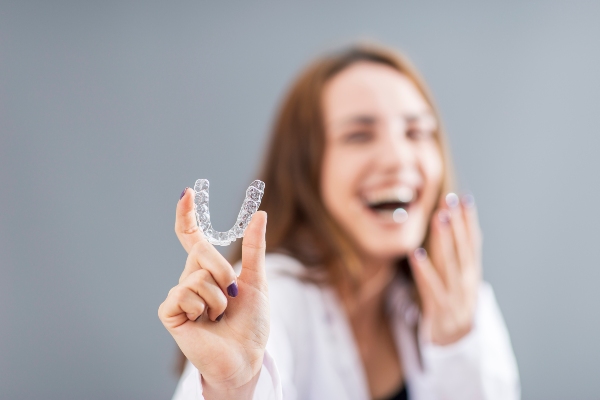A Pediatric Dentist Shares Tips to Prevent Cavity in Kids

Cavities are a common dental problem in young children. Even with routine visits to a pediatric dentist, kids are more at risk for tooth decay for a number of reasons, including:
- Poor home care
- Diets high in sugar
- Bottle and pacifier use
- Poorly aligned or overcrowded teeth
Fortunately, there are ways to prevent cavities and the uncomfortable dental work they often require.
Oral care
Home care often has the most significant impact on a child's potential for developing tooth decay. Professional cleanings, checkups, and treatments are also important for cavity prevention.
Brushing and flossing
Most dental professionals recommend that tooth brushing start when babies are around three months of age. This helps children become more comfortable with the process and can also help stimulate gum tissue. Once the teeth erupt, brushing twice a day with a non-fluoride toothpaste and flossing is recommended for all children, as it can significantly help prevent cavities. When children are able to brush without swallowing, it is time to switch to fluoride toothpaste for better protection.
A pediatric dentist may recommend that parents continue to help children brush and floss until the age of 6 or 7. Even then, continued supervision may be necessary for a thorough clean. Children may also add a fluoride mouth rinse around this age.
Regular checkups
While some parents may assume that dental checkups are not necessary until permanent teeth start to emerge, most experts recommend that these appointments begin by age one. Perhaps most significantly, this helps children build a foundation of trust with the pediatric dentist for less stress in the future. It also ensures that dentists can detect any decay or development issues early on in case treatment or intervention is needed. In addition, it can be challenging to effectively clean a young child's teeth, so a professional cleaning can help remove stubborn plaque and tartar buildup.
Optional treatments
The chewing surfaces of molars are particularly prone to cavities. Dental sealants can offer extra protection, especially in young children who are more susceptible to tooth decay. The dentist may also suggest a topical fluoride treatment that is painted on to strengthen the teeth's defense against cavities. The American Dental Association recommends topical fluoride treatments for most patients and dental sealants for cavity prevention in children ages 6 to 12.
Fluoride varnish that is painted on the teeth is not the only option for this type of treatment. Fluoride can also be applied to the teeth as a gel or foam. The foam variety is placed into a jaw-shaped tray that the child bites down onto for several minutes while the teeth absorb the fluoride. The gel can either be painted onto the teeth or applied using a tray.
Each method of applying a fluoride treatment has its strengths and weaknesses. Fluoride varnish remains on the teeth longer, but some children cannot sit still long enough for the application or do not like the taste. Children with sensitive gag reflexes may not tolerate keeping the tray in their mouths for foam or gel applications. The dentist and parents can decide which method is appropriate for each patient.
Lifestyle choices
Oral care is not the only way to reduce the risks for cavities in young children. Simple lifestyle adjustments can have a major impact as well. Limiting sweet treats and sugary drinks can help prevent tooth decay. Parents should carefully monitor finger-sucking, pacifier use, and bottle use to limit sugars and bacteria in the mouth. A child should never be sent to bed with a bottle or cup; it can be unsafe, and continuous sipping on milk or juice can lead to cavities.
It is not only foods and drinks that are sweet or sugary that can cause tooth decay but also those that are acidic. For example, many parents who are otherwise picky about what their children eat and drink give their children orange juice, believing that it is healthy for them. While orange juice does contain many important nutrients, it is often made from concentrate, meaning that it is extra acidic. It is better for parents to give their children fresh fruit to eat instead.
Conclusion
Preventative care goes a long way in reducing the risks for cavities in children. A pediatric dentist may make other specific recommendations to ensure your child is well protected from tooth decay. This can help kids develop a more positive view of dental care while enjoying a lifetime of better oral health.
Request an appointment here: https://www.orthodonticprecision.com or call Precision Orthodontics & Pediatric Dentistry at (703) 391-8800 for an appointment in our Reston office.
Check out what others are saying about our services on Yelp: Read our Yelp reviews.
Recent Posts
Invisalign® is a system of transparent aligners that are custom-made to fit a person's teeth. Like braces, it corrects alignment by delivering different levels of pressure to individual teeth. Since everyone has a unique smile, you will need a custom-made pair of Invisalign clear aligners. This article provides information on how clear aligners are custom-made…
Invisalign® aligners are a popular alternative to conventional metal braces. Although Invisalign offers more comfort than metal braces, it is impossible to eliminate the chances of mild pain or discomfort. The risk of discomfort seems to be highest during the first week of wearing invisible teeth aligners.A person’s pain tolerance also determines the degree of…
Thinking about getting Invisalign®? Read on to learn some of the benefits of choosing this teeth-straightening treatment. Most people want a beautiful smile, but many people do not want to undergo teeth-straightening treatments that involve conspicuous metal braces. Fortunately, another option called Invisalign involves wearing transparent aligner trays over time to correct tooth misalignment. A…
If you are considering Invisalign® treatment for teeth straightening, you will likely want details about the process. Read on to learn about what happens during and after Invisalign treatment. When you visit the orthodontist for a consultation, they will explain the specifics of what to anticipate during and after treatment. They will also discuss using…


